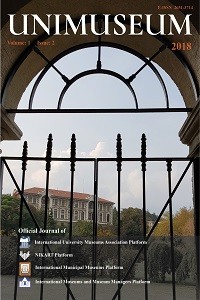Reshaping the past: Contemporary art museum’s potential to reshape the art history
Reshaping the past: Contemporary art museum’s potential to reshape the art history
Today, art history and its interpretation have changed with new museology applications. The potential to understand and perceive art history has changed over the years. Museums, owning large art collections, aim to spread and transmit knowledge in society, while reshaping the meaning of artworks as they maintain experienced-based exhibitions. Art museums also target to increase communication between artworks and visitors and develop programs specialized in their collections. Art museums also have the potential to drive the past into light with their temporary exhibitions and create new ways to understand art history within their exhibitions. Thus, being a new authority, museums add new meanings to the artworks, exhibition designs, classification of artworks, and spreading and transferring knowledge can change the interpretation of art history.
Keywords:
art history, semantic, art museums exhibitions,
___
- 1. Krstović, Nikola. (2020). Colonizing Knowledge: New Museology as Museology of News. Prace Etnograficzne. 48. 125-139.
- 2. Erbay, F Müze (2009) Yönetimini Kurumsallaştırma Çabası, Mimarlık Vakfı Enstitüsü, İstanbul
- 3. Chabala T, (2007, Mart), Museum Scholar Defends Museums, www.dornsife.usc.edu erişim tarihi: 8 Ocak 2022, https://dornsife.usc.edu/news/stories/280/princeton-scholar-defends-museums-says-art-is-cosmopolitan-not-t/
- 4. Lairos, P, Bourriaud, N röportaj (2021, Mart) Trouble afoot in Montpellier. www.frieze.com , erişim tarihi: 8 Ocak 2022, https://www.frieze.com/article/trouble-afoot-montpellier-nicolas-bourriaud-museum-politics
- 5. Preziosi, D, Art History and Museology: Rendering the Visible Eligible, Macdonald, S. Companion to Museum Studies. (Companions in Cultural Studies). Basil Blackwell Ltd. (2006)
- 6. Preziosi, D, In the Templeof Entelechy: The Museum as Evidentiary Artifact, Studies in the History of Art , 1996, Vol. 47, Symposium Papers XXVII: The Formation of National Collections of Art and Archaeology (1996), pp. 165-171
- 7. Buckland 1997: 805; Leone and Little 2007: 362 alıntı: Navarrete T., Mackenzie Owen J. (2016) The Museum as Information Space: Metadata and Documentation. In: Borowiecki K., Forbes N., Fresa A. (eds) Cultural Heritage in a Changing World. Springer, Cham
- 8. Hooper Greenhill, E. (1992). Museums and the Shaping of Knowledge (1st ed.). Routledge.
- 9. Navarrete T., Mackenzie Owen J. (2016) The Museum as Information Space: Metadata and Documentation. In: Borowiecki K., Forbes N., Fresa A. (eds) Cultural Heritage in a Changing World. Springer, Cham
- 10. Hegel, G.W.F Hegel’s Aesthetics: Lectures on Fine Arts. Çev: T. M. Knox. Oxford; (The Clarendon Press, 1975) s. 10.
- 11. Joshua M. Gorman (2011) Universalism and the new museology: impacts on the ethics of authority and ownership, Museum Management and Curatorship, 26:2, 149-162
- 12. Erbay, F. Geleceğin Müzeleri ve Değişim Stratejileri, Sanat, Tarih, Mimarlık Dergisi, 11:2013, 19-30
- 13. Deirdre C. Stam (1993) The informed muse: The implications of ‘the new museology’ for museum practice, Museum Management and Curatorship, 12:3, 267-283
- 14. Ross, M. (2015). Interpreting the new museology. Mathematical Models and Methods in Applied Sciences, 2, 84-103.
- 15. Erbay, F Müzeleri Kurumsallaştırma Çabası, 2006, Mimarlık Enstitüsü Yayınları, İstanbul
- 16. Navarrete T., Mackenzie Owen J. (2016) The Museum as Information Space: Metadata and Documentation. In: Borowiecki K., Forbes N., Fresa A. (eds) Cultural Heritage in a Changing World. Springer, Cham
- 17. Deirdre C. Stam (1993) The informed muse: The implications of ‘the new museology’ for museum practice, Museum Management and Curatorship, 12:3, 267-283
- ISSN: 2651-3714
- Başlangıç: 2018
- Yayıncı: Fethiye ERBAY
Sayıdaki Diğer Makaleler
Reshaping the past: Contemporary art museum’s potential to reshape the art history
MÜZE-SİNEMA İLİŞKİSİNİ SOYGUN FİLMLERİ ÜZERİNDEN DEĞERLENDİRMEK
A.B.D VASSAR KOLEJİ / LOEB SANAT MERKEZİ
Amerikan Müzeleri ve Aktivizm: Sosyal Uyanışlar, Değişen Misyonlar
